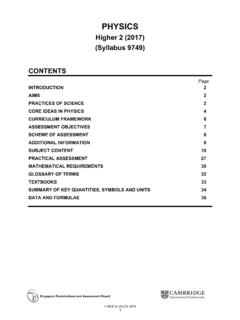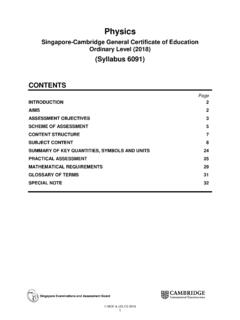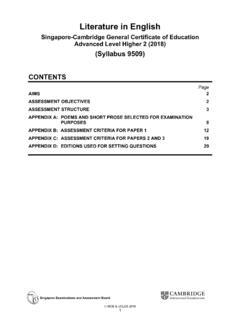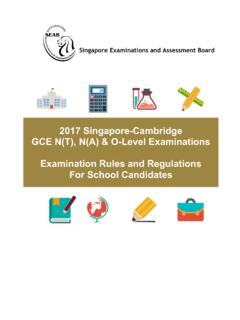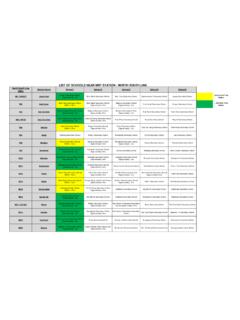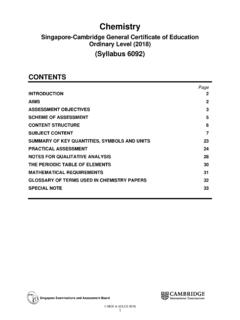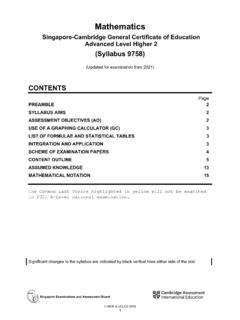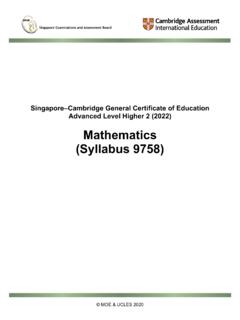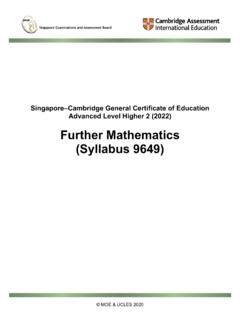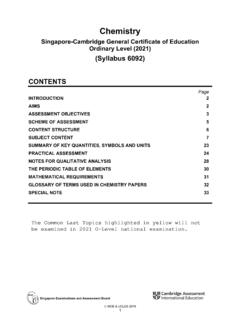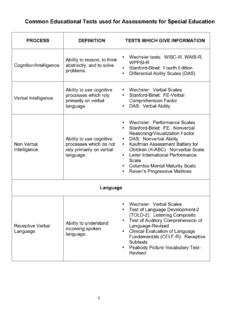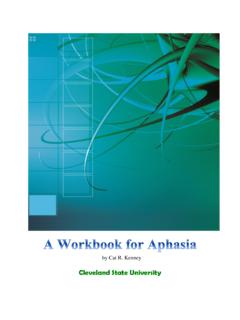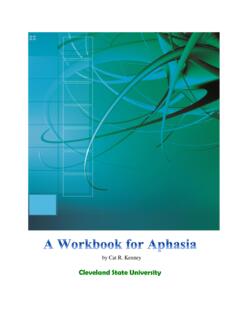Transcription of English Language (Syllabus 1128) - SEAB
1 Singapore Cambridge General Certificate of Education Ordinary Level (2022). English Language ( syllabus 1128). MOE & UCLES 2020. 1128 English Language GCE ORDINARY LEVEL syllabus . CONTENTS. Page AIMS OF TEACHING syllabus 3. ASSESSMENT OBJECTIVES 3. SCHEME OF ASSESSMENT 4. PAPER DESCRIPTION 5. GENERIC BAND DESCRIPTORS 7. 2. 1128 English Language GCE ORDINARY LEVEL syllabus . AIMS OF TEACHING syllabus . By the end of Secondary education, pupils will be able to communicate effectively in English as a result of their development in the following areas: 1. Listen, read and view critically and with accuracy, understanding and appreciation, a wide range of literary and informational/functional texts from print and non-print sources.
2 2. Speak, write and represent in internationally acceptable English (Standard English ) that is grammatical, fluent, mutually intelligible and appropriate for different purposes, audiences, contexts and cultures. 3. Understand and use internationally acceptable English (Standard English ) grammar and vocabulary accurately and appropriately as well as understand how speakers/writers put words together and use Language to communicate meaning and achieve impact. These aims, taken from English Language syllabus 2010: Primary & Secondary (Express/Normal [Academic]), , form the broad basis of a course of study; they may not all be translated into Assessment Objectives for formal examination.
3 ASSESSMENT OBJECTIVES. In this English Language examination, candidates will be assessed on their ability to: speak and write in internationally acceptable English respond, in speech or writing, to a variety of written, spoken and visual texts speak, read aloud and write to suit purpose, audience and context speak and write using appropriate register and tone speak and write clearly, effectively, relevantly and coherently plan, organise and show development of ideas use varied sentence structures and a wide and appropriate vocabulary with clarity and precision use correct grammar, punctuation and spelling show understanding of a variety of written.
4 Spoken and visual texts at the literal, inferential and evaluative levels show understanding of how use of Language achieves purpose and impact identify main ideas and details in written, spoken and visual texts synthesise, summarise and organise information read aloud a given text with accurate pronunciation and clear articulation read aloud a given text fluently with appropriate variations in voice qualities, pace, volume, tone and stress. 3. 1128 English Language GCE ORDINARY LEVEL syllabus . SCHEME OF ASSESSMENT. Paper Description Marks Weighting Duration (%). 1 Writing 70 1 hour 50 minutes Section A: Editing (10).
5 Candidates identify and edit grammatical errors in a short written text. Section B: Situational Writing (30). Candidates write 250 350 words on a given situation which will involve viewing a visual text. Section C: Continuous Writing (30). Candidates write 350 500 words on one of four topics set. 2 Comprehension 50 1 hour 50 minutes Section A (5). Candidates respond to questions based on Text 1, a visual text. Section B (20). Candidates respond to a variety of questions based on Text 2 which is a narrative or a recount. Section C (25). Candidates respond to a variety of questions based on Text 3, a non-narrative text, and write an 80-word response to a summary writing task.
6 3 Listening 30 About 45 minutes Section A (24). Candidates respond to a variety of listening tasks based on a number of audio recordings which the candidates will hear twice. Section B (6). Candidates listen to an audio recording and do a simple note-taking exercise. Candidates will hear the recording only once. 4 Oral Communication 30 About 20 minutes The two parts in this paper are thematically linked. (including 10 minutes of part 1: Reading Aloud (10) preparation Candidates read aloud a short text, presented on a time). computer screen. part 2: Spoken Interaction (20).
7 Candidates engage in a discussion with the Examiners on a topic based on a visual stimulus in the form of a video clip. Total 180 4. 1128 English Language GCE ORDINARY LEVEL syllabus . PAPER DESCRIPTION. Candidates are required to sit all four papers. Paper 1 Writing [70 marks]. Duration of Paper 1: 1 hour 50 minutes This paper is divided into three sections. Section A: Editing [10 marks]. In a given text of continuous prose of not more than 250 words, candidates identify and then edit grammatical errors by writing the corrections in the spaces provided. Errors in punctuation and spelling will not be tested in this section.
8 Section B: Situational Writing [30 marks]. Candidates write a text of 250 350 words based on a given situation which will involve viewing a visual text. Candidates are required to write the text ( an email, a letter, a report or a speech ) to suit the purpose, audience and context. Section C: Continuous Writing [30 marks]. Candidates choose one out of four topics to write a text of 350 500 words in continuous prose. The topics set may cover different types of texts, narrative or exposition. Paper 2 Comprehension [50 marks]. Duration of Paper 2: 1 hour 50 minutes This paper is divided into three sections.
9 Section A [5 marks]. This section contains Text 1 which will include visuals. Based on the visual text, candidates are required to answer a variety of questions testing comprehension, and on the use of visuals as well as the use of Language for impact. Section B [20 marks]. This section contains Text 2, which is narrative in nature, based on which candidates are to answer questions testing comprehension, vocabulary in context and the use of Language for impact. Section C [25 marks]. This section contains Text 3, which is non-narrative in nature, based on which candidates are required to answer questions testing comprehension, vocabulary in context and the use of Language for impact.
10 Candidates are also required to write a summary of about 80 words (excluding the introductory words that will be provided). Texts 2 and 3 together will be about 1200 words long. Paper 3 Listening [30 marks]. Approximate duration of Paper 3: 45 minutes This paper comprises two sections. Section A [24 marks]. Candidates respond to a variety of listening tasks that will assess a range of listening skills. The audio texts, which will consist of a variety of types of texts, narrative, recount, exposition, and information report, may come with visuals where appropriate. A variety of question types, multiple choice, matching , fill-in-the- blanks, true/false/not stated, and filling in a graphic organiser, may be set.
